The Kashi Vishwanath corridor in Varanasi causes ripples of alarm
The corridor in Varanasi promises to be a thing of beauty when complete. However, environmentalists are not impressed. Construction on the river bed and debris being dumped are polluting the Ganga and forcing her to change course, they say.

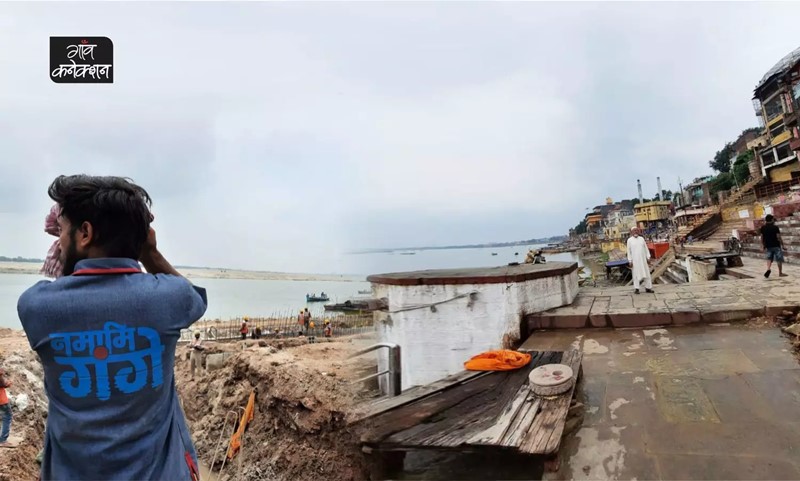
Environmentalists and the people of Varanasi are worried that debris from construction work at Lalita Ghat is being dumped into the river. All photos by Shashwat
Varanasi, Uttar Pradesh
The waters of the beauteous Ganges are turning murky, especially near Lalita Ghat in Varanasi, worrying lovers of the river and environmentalists alike. The local administration is blaming it on the Mirzapur district sewage treatment plant located more than 60 kms away from Lalita Ghat, which has led to the growth of the dirty green algae.
However, river experts say that the building activity at the ghats is the reason for the stagnation and discoloration of the water. They fear this will not just mar Ganga’s beauty but will also push her away from the ghats.
The Kashi Vishwanath corridor project is meant to beautify the area falling between Lalita Ghat and the Kashi Vishwanath temple. A ramp 100 feet long and 150 feet wide that goes right into the river has interrupted the free flow of water.

The corridor will cover an area of 500,000 square feet. Construction work is going on in about 30 per cent of the area. A fleet of steps is being constructed on the banks of the Ganges between Lalita Ghat and Manikarnika Ghat. Alongside this, there are also plans to construct an open air stage near the Jalasen Ghat.
Environmentalists alarmed
Environmentalists and the people of Varanasi are worried that debris from construction work at Lalita Ghat is being dumped into the river. In addition, walls are being erected on the river bed. “We fear this may change the course of the river,” P Vishwambarnath Misra, professor of physics at Banaras Hindu University, and priest at the Sankatmochan temple, told Gaon Connection.
When concerns were raised about the spreading algae in the river and the changing colour of water at Lalita Ghat, Kaushal Raj Sharma, district magistrate,Varanasi, instituted a five-member-committee, on June 8 this year. He directed the committee to enquire into the matter and present a report in three days.
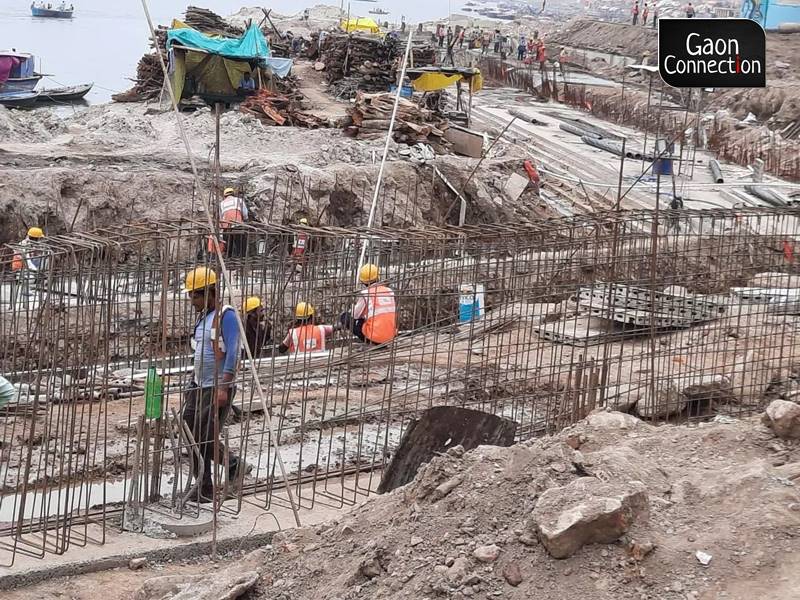
The committee took a ride on the river, collected water samples to test and declared that the sewage treatment plant at Mirzapur was responsible for the algae formation at Lalita Ghat, and not the construction activity.
“The Mirzapur STP is old and this algae you see in the water is because of that,” Devi Dayal Varma, Varanasi’s additional municipal commissioner, also told Gaon Connection.
Varma also claimed the river was flowing freely. He said Kalika Singh and Mahendra Srivastav, members of the pollution control board, had inspected the area and found nothing alarming.
Dismay and distress
But the locals have another story to tell. “We come to Gangaji every morning.We have never seen water in this colour before,” Dev Kumar, who sells flowers and incense required for the last rites at Manikarnika Ghat, told Gaon Connection
Kumar complained that even his income had suffered because of the corridor project. “Those of us who earned our livelihood here are not happy about this at all,” he said.
Also Read: The Toymakers of Varanasi: Crushed by COVID-19 and Chinese imports
There is outrage in several quarters about the insufficient study and research that went into the corridor project. Independent journalist Avadesh Dikshit, who has been writing about the Ganges for years, said there was no doubt that the construction within the river would affect its flow.
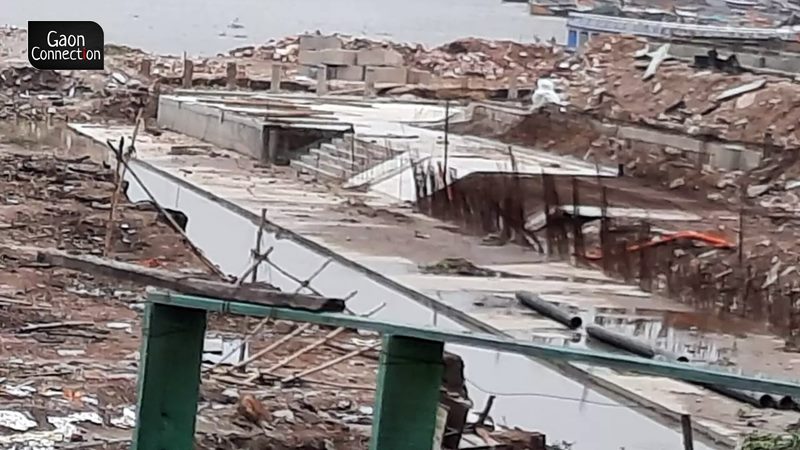
Dikshit demanded to know what research had been done on the matter before launching the project. “If there was research done, the findings should be made public, or, at least, the names of the researchers should be shared with the people,” he told Gaon Connection.
“A scientific study was conducted before construction began on the river,” municipal commissioner Varma said. “Any work to be undertaken near or on the Ganges is first researched. Experts survey it before work begins,” he added.
Pushing Ganga away
“The ramp is going to force the river away from the ghat, the water will become less deep and there will be a lot of silting between Dashaswamedh Ghat and Assi Ghat,” UK Chaudhary, a professor at Banaras Hindu University and a riverologist, told Gaon Connection.
According to Chaudhary, the dam-like structure being built at Lalita Ghat is at a 90 degree angle, which will stop the straight flow of the river. “It is difficult to predict what will happen in the future. The river will start flowing eastward and there will be a lot of silting in the ghats down the river too,” Chaudhary said.
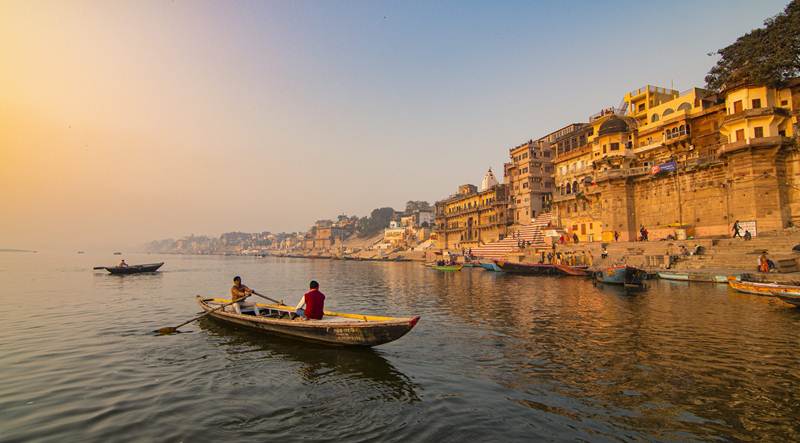
According to Vishwambarnath Mishra, it won’t be long before the river will be choked with mud, like it has already happened between the new Assi Ghat and the Ganga Mahal Ghat.
Also Read: Care for a walk — a 3,000-kilometre walk along the River Ganga?
“This is not just Ganges river. It is the lifeline of Banaras; this development work is going on without any thought of the consequences of how this will affect the city,” Mishra said emotionally. We will realise the damage in just a few years’ time, he said.
All clearances obtained, say government officials
Government officials and those involved with the construction at Lalita Ghat continue to be in denial and dismiss the apprehensions.
Also Read: Widows in Varanasi miss the COVID19 vaccine bus for want of proof of identity
“The work being done at Lalita ghat is not responsible for the algae,” Sunil Varma, member of the Kashivishwanath Temple trust told Gaon Connection. “In 2018, members of the Water Authority and the municipal corporation had obtained NOCs (No Objection Certificates) from all concerned departments,” Varma said in response to questions about the environmental impact assessment reports and pre-feasibility reports. “The public works department is the executing agency of this project,” he added.
Varma refused to comment on fears of the river changing its course, saying the corridor was still a work in progress and he was not willing to say anything more.
“The engineers know their jobs, and if there is any adverse effect once the project is over, we will set it right then,” Varma declared.
“These developmental projects are proceeding towards a dead end, and we can’t retrace our steps either,” Vyomesh Shukla, theatre director and poet, told Gaon Connection.
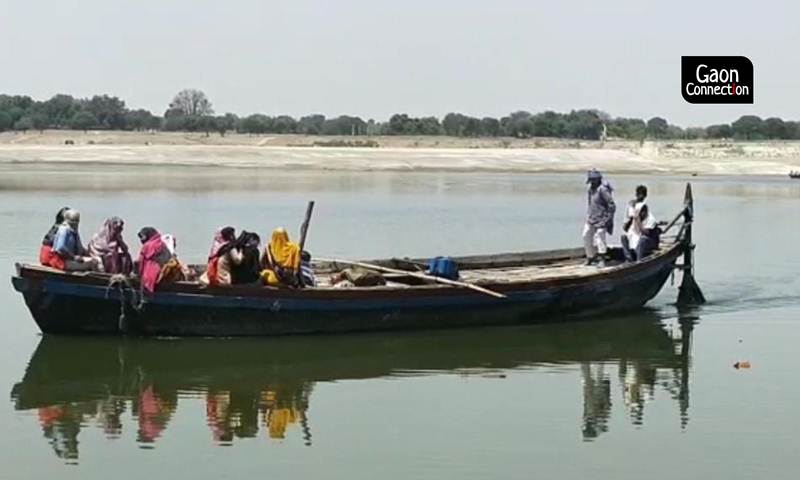
“The spiritual splendour of Lalita Ghat will be damaged forever, and there will be an adverse impact on the city’s drinking water,” Shukla mourned. “The identity of Banaras is the flowing Ganges river, and the ramp will force Ganga to leave the ghats,” he said.
The pre-feasibility report is the foundation on which any project of this kind can take off. The environmental report put together by experts in the field takes into consideration the impact, good or otherwise, on not just the ecology, but also on people, Shukla explained. He professed shock that no such reports are in the public domain. Ask the authorities, and they get flustered, he added.
Lost livelihoods
“I have no idea what is happening. All I know is that my home fell in the corridor and it was broken down,” Ram Kumar a boatman at Lalita Ghat for 20 years, told Gaon Connection. Displaced from what he always thought of as home, he crossed over to the other side of the river. Ram Kumar got a compensation of Rs 5 Lakh, but that will not make his troubles disappear, he said.
Also Read: The boatmen of Mirzapur are in troubled waters
“If the river leaves the ghats, where do we anchor our boats? Our only means of livelihood will dry up,” he lamented.
Boatmen like Ram Kumar and the public at large are not allowed in the area where the corridor is being constructed. Photography is also prohibited.
Read the story in Hindi

